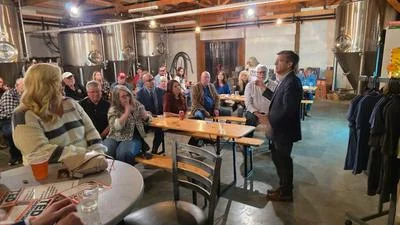University of Illinois College of Engineering issued the following announcement on Sept. 10
With colleagues at several institutions, University of Illinois Urbana-Champaign crop sciences professor Stephen Moose will lead the development of a National Science Foundation Science and Technology Center for Research on Programmable Plant Systems. With $25 million in newly announced funding, the center “will create an Internet of Living Things to learn the intimate biological language of plants and their associated organisms.” Moose spoke with News Bureau life sciences editor Diana Yates about this new initiative.
What is digital agriculture and why do we need it?
Despite enormous progress in our biological understanding of plants and plant-associated organisms, basic and vitally important questions remain unanswered. We still lack a complete genetic and physiological understanding of plant responses to multiple stresses, for example, from drought, heat, high carbon dioxide, nitrogen deficiency and pathogens. We also have only a basic understanding of the factors that contribute to plant size, shape and architecture, or of mechanisms that control how plants grow, develop and interact with beneficial or pathogenic microbes.
Current approaches to plant breeding and genetics are powerful but need to gain efficiency. At the same time, we are witnessing explosive growth in data-driven analytics, nanotechnology, synthetic biology, imaging and robotics. These advances are poised to initiate a new wave of discovery and innovation in the plant sciences. We envision new sensor hardware to capture and digitize the physical and biological parameters of plants that drive productivity. This enables plants and their associated organisms to communicate directly with the digital realm. We also hope to create an “Internet of Living Things,” in which programmable plant systems report on their deep biology and also respond to signals derived from processed data.
How would plants engage in digital communication?
We will develop a suite of biotechnological tools for converting hidden plant processes into digital signals, and for plant processes to respond to digital inputs. These innovations will mediate two-way communication between plants, plant-associated microbes, and insects, and a new digital framework to process the information and program adjustments to these systems. For example, we aim to engineer plants in which the activities of underground soil microbes are reported in above-ground leaves that are much easier to monitor. This information can be used to program changes in plant growth that optimize the timing of irrigation or application of fertilizer to further boost crop productivity.
How will this advance efforts to adapt to a changing climate?
Plants are constantly integrating information about their environment and adjusting their growth. Our hope is that the creation of programmable plant systems will enable a data-driven approach to better understand how plants respond to environmental change, particularly across different biological scales. As just one example, current efforts to model crop productivity consider the plant as a static entity, but programmable plants will refine these models to better predict how crops will perform in future environments.
What other innovations will this approach make possible?
We will deploy our programmable plant systems in the field and expect to analyze high volumes of data. Our center will develop new strategies for automated data collection, wireless data transfer and cloud processing. These innovations will not only advance discovery in the center, but can also be applied more broadly in digital agriculture.
What is the biggest challenge ahead for this work?
Building the programmable plants will be challenging, as they currently are a design concept that needs prototyping. However, a major strength of our team across institutions is experience in plant improvement using genetics and genome editing. The center will explore how robotics and automation can speed up building programmable plants.
Original source can be found here.






 Alerts Sign-up
Alerts Sign-up